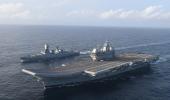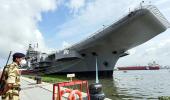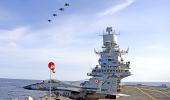The Indian Navy has a big role to play in support of our strategic objectives in the Indian Ocean.
The increasing Chinese presence in the Indian Ocean is a matter of concern and need to be factored.
Hence, the requirement of an Aircraft Carrier is a foregone conclusion, asserts Commodore Venugopal Menon (retd).
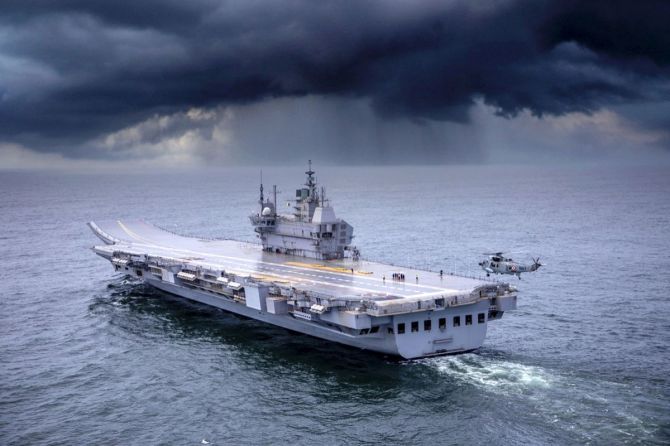
Warship construction kicked off in India with the government approving the construction of three Leander Class Frigates in 1960.
Construction of ships was undertaken at the Mazagaon Shipyard in Bombay and the first ship of the class, INS Nilgiri was commissioned on June 3, 1972.
Since then, Indian shipyards constructed many warships, slowly progressing from a buyer's Navy to a builder's Navy.
The commissioning of INS Vikrant is a red letter day in the chronicle of India's warship building capability taking the country to the exclusive league of the US, UK, France, Russia and China in building an aircraft carrier.
The keel of the carrier was laid at the Cochin Shipyard on Februry 28, 2009, the ship was launched on August 12, 2013.
The Vikrant is designed by the Directorate of Naval Design and the first warship to be built at Cochin Shipyard.
The Defence Metallurgical Laboratory and the Steel Authority of India Limited created facilities to manufacture DMR 249 grade steel in India.
About 26000 tonnes of special steel was manufactured in our steel plants and the Vikrant is the first ship of the Indian Navy to be built completely using domestically produced steel.
The shipyard used the modular construction technique in building the Vikrant.
An important aspect to note is that about 90% of the hull, 50% of the machinery and 30% of weapons and sensors are indigenously designed and built.
Maritime Interests of Nations
The maritime domain and the enormous amount of traffic that passes through it, is the foundation of global trade.
Energy security, which is a supporting pillar of the global economy, is greatly influenced by the stability of maritime environment.
Intercontinental trade, bulk transport of raw materials, and import/export of affordable food and manufactured goods would simply not be possible without a safe maritime environment.
In today's geo-political framework, it is clear that economic prosperity and security of countries are linked to safe sea lanes of communication.
Therefore, a crisis or conflict anywhere on the world affecting the waterways and freedom of navigation will have adverse impact on the global economy.
Strategic Value of an Aircraft Carrier
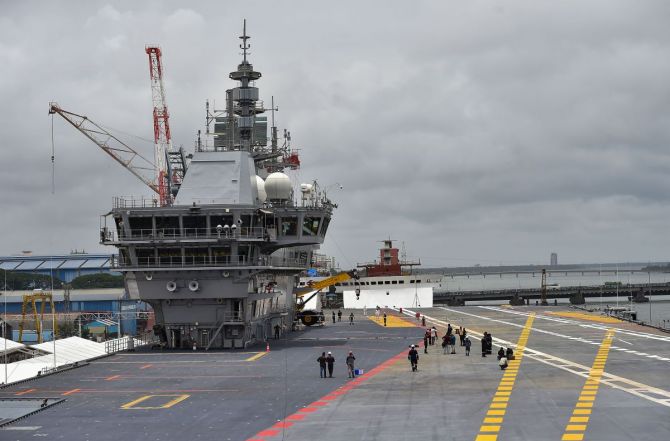
While many nations have brown-water or littoral naval capability or Coast Guards to enforce the UN Convention on the Law of the Sea, these have limited reach and power.
In order to ensure safety of major sea routes and choke points, sometimes a stronger military deterrent force is required to project power at sea.
The most recognisable icon of maritime power since the end of World War Two has been the aircraft carrier.
Aircraft carriers are platforms that allow the projection of national power almost anywhere in the world.
Maritime Role of a Carrier
The overall Air Power that an aircraft carrier brings to the operational area is not only limited to the tremendous capabilities that the fixed-wing aircraft can deliver.
It includes the capabilities of organic rotary-wing assets and of the cruise missiles and other armaments on the escort ships that form part of a Carrier Strike Group (CSG).
An aircraft carrier is considered the most valuable sea-based asset and offers an incomparable military instrument with its ability to project tactical Air Power over long distances, including Air Interdiction, Anti-Surface Warfare (ASuW), offensive and defensive Counter-Air and Air Early Warning (AEW)
Mobility of a Carrier
The freedom of navigation and overflight in international waters, the right of innocent passage through the territorial waters and the right of transit passage through international straits all guaranteed in the United Nations Convention on the Law of the Sea, implies that a CSG has worldwide mobility.
It has potential access to almost any area of crisis, considering that the earth is covered two third by water and is capable to arrive on station relatively quickly and sustain in the area for prolonged operations.
As a floating airbase, an aircraft carrier combines operational flexibility and speed of intervention to project power in a crisis spot without going through the problems of political compromises and diplomatic approvals.
Whereas in the case of land based air power, diplomatic approvals are required to operate aircrafts from a foreign air base as also clearances to overfly airspace of other countries.
Flexibility & Sustenance of a CSG
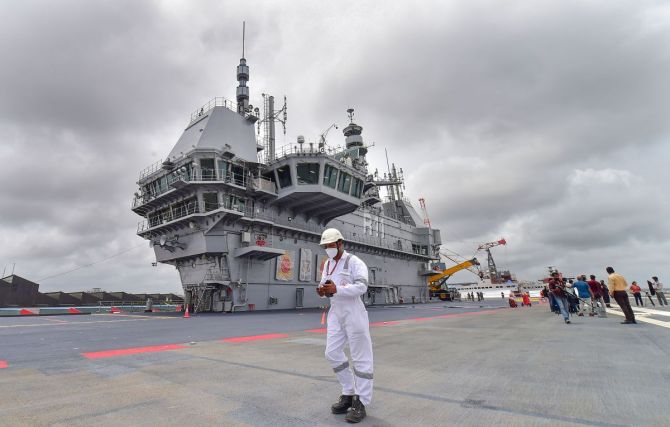
Maritime forces have long-range capabilities and the capacity to sustain at sea for a prolonged period with limited logistic dependence.
This endurance can be further extended by their capability for replenishment at sea.
A Carrier Strike Group is therefore able to operate independently for prolonged periods, even in the absence of a host nation, and to cover greater distances.
Sea-based air missions, with the carrier cruising beyond the visual horizon, allow operations out of the view of prying eyes which also ensures surprise.
Diplomatic Role of a Carrier
An aircraft carrier is more than just a military platform as it is an important diplomatic tool, able to exert influence by its mere presence in an area, and to deliver a strong intent.
From a political perspective, a CSG constitutes a highly adaptable instrument of power to control a threat in an early stage and preventing the crisis to flare up.
Operational Life of a Carrier
An Aircraft Carrier has an operational service life of approximately 50 years with proper maintenance including periodic dry docking.
Naval aviation is an inherently dangerous business, and that adequate funding.
professional maintenance and training are required for safe and effective air operations at sea.
Power Projection Ability of a Carrier
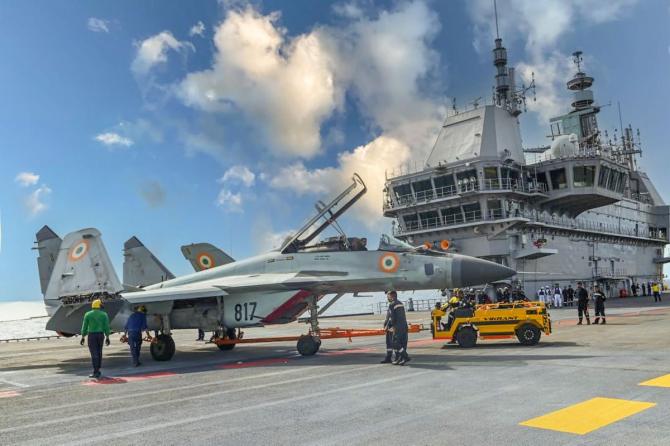
A Carrier is an operationally versatile asset, capable of being effectively integrated into a combined multinational campaign and is the only instrument capable of intervening in the initial phase of an operation during a crisis.
Its mere presence in the area establishes a credible naval and air presence in support of national interests and political objectives.
While expensive to buy and operate, it is ultimately less expensive and far more flexible both militarily and politically than deploying and sustaining land-based air assets to a friendly host nation.
Strategic Imperatives of a Carrier for Indian Navy
The Indo Pacific is largely a maritime-configured region. Therefore, there is much rationale for a regional power like India to possess a Carrier.
Even if India could obtain access to overseas air-bases for use by its land-based aircraft, they may not be available in the most critical occasion due to geo-political factors.
Some of the possible scenarios that makes a Carrier indispensable are examined in the succeeding paragraphs.
Readers may note that Submarines are an equally important asset for a blue water navy but their roles are different from that of a Carrier.
Support of Land Battle:
The concept of using a Carrier in support of a continental war is not new to India.
During the 1971 operations for the liberation of Bangladesh, aircraft on board the then INS Vikrant were employed successfully to strike strategic targets deep inside erstwhile East Pakistan.
Similarly Carrier-borne air power can be used to strike strategic targets on the Makhran coast and interdict shipping on the western seaboard.
Security of Sea-Lines of Communication (SLOC)
In the event of a military conflict, a CSG is the only naval asset that can provide a comprehensive protection to merchant shipping which carry oil, gas and essential commodities towards sustaining the war effort.
Maritime Influence in the Indian Ocean Region:
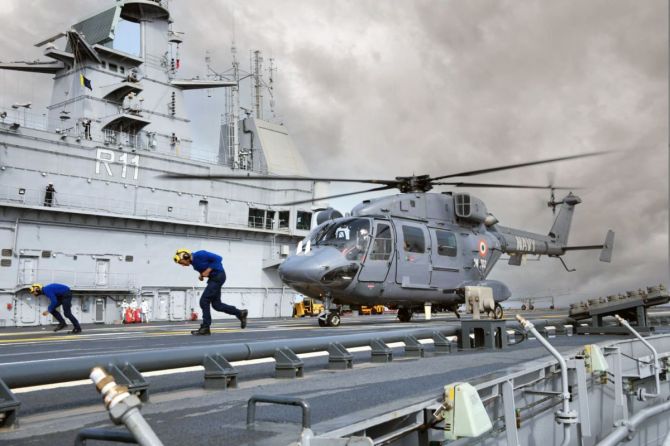
India's security is directly linked to that of the Indian Ocean and the adjoining littoral region, the Indian Ocean Region.
This region is of primary strategic interest to India. Chinese influence in the region through its Belt and Road Initiative has strengthened during the last decade.
China is quite capable of leveraging their economic clout to influence the countries in the region to support their military objectives, thereby displacing India's influence in the Indian ocean region.
In such a futuristic scenario, presence of a Carrier would be of deterrent value and would ensure India s ability to maintain influence in our area of interest .
Safeguarding Vital Interests Overseas
An Aircraft Carrier will enable India to safeguard its strategic interests overseas, not only in the Indian Ocean Region, but also beyond.
India's economic/strategic stakes are conspicuously increasing in the Indian Ocean Region as per our neighborhood first policy and in SE Asia in accordance with our look east policy.
Safety of our nationals working in these regions is also of prime concern in an eventuality.
Quick deployment of the Carrier to a crisis scene can ensure safe evacuation of personnel in addition to sending a political message.
Security of Island Territories:
Air assets play a significant role towards defense of our far flung island territories and a Carrier has the flexibility to expeditiously deploy air assets at such distances to meet any contingency.
Geostrategic location of the islands which are situated about 1,000 km from the Indian coast as in the case of Andaman and Nicobar islands makes these islands vulnerable to clandestine activities especially in uninhabited islands.
Support of Amphibious Operations/Assault
In a possible scenario of any of our distant islands being occupied by the adversary, an amphibious assault/landing would be the only alternative to regain the territory.
Sea control over the area for a certain amount of time would be prerequisite for a successful amphibious operation.
The Aircraft Carrier plays the key role in achieving Sea control.
India's Role as a Net Security Provider
The term net security provider signifies the role a nation to provide maritime security in a region by addressing common security concerns which include dealing with transnational piracy or responding to natural disasters.
Specifically, it encompasses four different activities viz capacity building, military diplomacy, military assistance and direct deployment of military forces to aid or stabilize a situation.
Geostrategic location of India makes it an important player in the region for taking initiative to be the first responder to crisis situations due to its transitional position in the Indian Ocean, middle of the ocean trade routes interconnecting the Atlantic and Pacific and having the Naval power to provide safety and security to trade in the region.
Presence of a Carrier makes a significant impact in our role as the net security provider as it sends a diplomatic and political message in addition to displaying the operational intent.
Non-military Missions
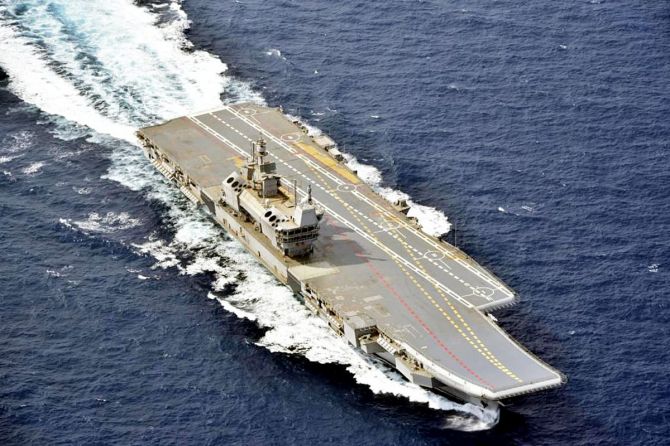
The Indian Ocean Region has been a victim of natural disasters and being the net security provider in the region, one of our primary mission at sea is Humanitarian Assistance and Disaster Relief (HADR).
A CSG has the flexibility mobility and sustenance to play a key role in HADR missions.
A CSG serves the dual purpose of creating an air bridge at locations which has been destroyed by the natural disaster in addition to a sea bridge created by LCAC/LCU ( Landing Craft Air Cushion/Landing Craft Utility )deployed from Landing ships which are part of the operation.
In addition, the CSG can act as the logistics hub at sea due to its capacity to carry stores, fresh water, medicines, engineering and electrical equipment.
Life saving appliances which are essential ingredient for a first responder to crisis situations.
Advantages of Carrier borne air power over Shore based Aircraft
- Time on task of a land-based aircraft in the conflict zone would be significantly less than that of a Carrier borne aircraft.
- Limitations in the quantum of ordinance that can be delivered by a shore based aircraft operating at extended ranges.
- Although endurance of a shore based aircraft can be increased by air to air refueling, the evolution is extremely risky as both the tanker and receiving aircraft would be extremely vulnerable to enemy attack.
- A carrier would be able to operate from a much shorter distance from the conflict area and would be able to assess the ground situation better as compared to a shore based aircraft.
- Based on the above, the combat readiness of the crew would be less subjected to fatigue as compared to a shore based air crew operating from a distant location.
- Tactical situation can change after the launch of shore based strike aircraft and the sortie would not yield results due to change in situation.
Whereas in the case of a Carrier borne aircraft the command would be update on the tactical situation as the vessel would be close to the scene of action.
Further, the aircraft can be recalled and turned around in the shortest possible time-based on the change in tactical situation.
Use of air strips on island territories in lieu of a Carrier
There has been much talk in strategic forums on the use of air strips on the Andaman and Nicobar islands as an alternative to a Carrier.
Needless to say, an air strip on an island is a fixed asset and would be vulnerable to all types of attacks to render it unserviceable in the early stages of hostilities.
Further, such air strips lack the flexibility of a Carrier to deliver the ordinance based on changing tactical situation.
Vulnerability of a Carrier
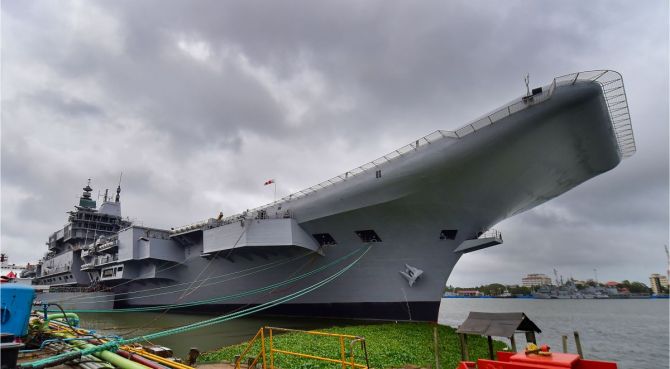
This is an argument often seen in strategic forums from the lobby who are not in favor of a Carrier.
Every ship at sea face multi dimensional threat in today s maritime domain and have to go in the harm s way to achieve maritime objectives.
Although the term Carrier is singular, readers must note that Carriers do not operate independently.
They normally operate as a CSG (Carrier Strike Group) or a Carrier Battle Group (CBG).
The only difference between the two is that the number of escorts are more in the case of a CBG.
The concept of CSG is more acceptable and practical for big Navies due to shortage of escort vessels and wide range of tasks that the Navies are required to perform based on strategic objectives of Governments.
Needless to say, a CSG moves through a sanitised zone of about 500 nautical miles plus all round as it is complemented by AEW aircraft, LRMP aircraft and helicopters on the advanced screen.
In brief, the Carrier would be protected to transit through a multi-threat environment.
Another important point to note is that the Carrier is a strategic asset and her deployment would be mission oriented and therefore the foray into positioning for offensive missions and exposure would be well deliberated and calculated to ensure minimum exposure.
Conclusion
Based on the above factors, I am of the view that an Aircraft Carrier is a valuable asset for the Indian Navy and its advantages outweigh the capital and operational costs and its perceived vulnerabilities.
As a regional power, the Indian Navy has a big role to play in support of our strategic objectives in the Indian Ocean.
Increasing Chinese presence in the Indian Ocean is a matter of concern and need to be factored.
Hence, the requirement of a Carrier is a foregone conclusion.
The objective of the country's maritime strategy should focus on the number of Carriers required to meet our strategic objectives and maritime missions.
Commodore Venugopal Menon served in the Indian Navy for 29 years in operational roles, including commands at sea, and training and staff assignments at Naval HQ.
In addition to the staff and war courses in the Indian Navy, he underwent the executive course at the Asia Pacific Centre for Security Studies, Honolulu.
Feature Presentation: Aslam Hunani/Rediff.com


